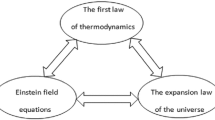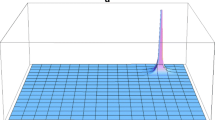Summary
Assuming the propagation of electromagnetic quanta to be governed by a rigorous continuity equation, we show that the requirement that this equation have the form of the usual Lorentz-covariant electromagnetic wave equation in vacuum implies properties of space-time which an observer is likely to describe as a uniform expansion in agreement with Hubble's law. By this approach the interference properties of quanta are also derived. The possible small-scale variations of the Hubble constant, suggested by observations of some extra-galactic objects, would with this interpretation of the galactic redshift appear less mysterious.
Riassunto
Supponendo che la propagazione dei quanti elettromagnetici sia governata da un'equazione di continuità rigorosa, si mostra che la condizione che questa equazione abbia la forma della solita equazione d'onda elettromagnetica nel moto, covariante secondo Lorentz, coinvolge proprietà dello spazio-tempo che un osservatore può descrivere come un'espansione uniforme d'accordo con la legge di Hubble. Da questo approccio si deducono anche le proprietà d'interferenza dei quanti. Le possibili variazioni in piccola scala della costante di Hubble, suggerite da osservazioni di certi oggetti extragalattici. apparirebbero meno misteriose con questa interpretazione dello spostamento verso il rosso delle galassic.
Резюме
Предполагая, что распространение злектромагнитных квантов определяется точным уравнением непрерывности, показывается, что из требования, чтобы это уравнение имело форму обычного Лорентц-ковариантного уравнения для электромагнитной волны в вакууме, вытекают свойства пространства-времени, которые следует, вероятно, описывать, как однородное расширение в соответствии с законом Хзббла. Используя этот подход, также выводятся свойства интерференции квантов. В связи с этой интерпретацией галактического красного смещения возможные мелкомасштабные изменения постоянной Хэббла, которые можно предположуть, исходя из наблюдений некоторых внегалактических обБектов, по-видимому, оказываются менее таинственными.
Similar content being viewed by others
References
E. P. Hubble:Astrophys. Journ.,69, 103, (1929).
M. S. Longair:Rep. Progr. Phys.,34, 1125 (1971).
W. D. Metz:Science. 178, 600 (1972).
G. de Vaucouleurs andA. de Vaucouleurs:Nature.236, 166 (1972);T. Jaakkola:Nature.234, 534 (1971);G. R. Burbidge:Nature Phys. Sci.,246, 17 (1973);J. Schneider:Europhys. News. 5, 6 (1974).
See.e.g.,J. C. Pecker,A. P. Roberts andJ. P. Vigier:Nature,237, 227 (1972).
W. Kundt:Origin of the Universe, inTrends in Physics (Petit-Laney, 1973), p. 1.
A. Einstein:Ann. der. Phys.,17, 891 (1905).
T. R. Gerholm:Fysiken och Människan (Stockholm, 1962), p. 163.
A. M. Weinberg andE. P. Wigner:The Physical Theory of Neutron Chain Reactors (Chicago, Ill., 1958), p. 220.
H. Margenau andG. M. Murphy:The Mathematics of Physics and Chemistry (Princeton, N. J., 1956), p. 442.
N. M. Schaeffer, Editor:Reactor Shielding for Nuclear Engineers (Oak Ridge, Tenn., 1973), p. 30, 35.
S. Glasstone andM. C. Edlund:The Elements of Nuclear Reactor Theory (Princeton, N. J., 1962), p. 46.
P. M. Morse andH. Feshbach:Methods of Theoretical Physics (New York, N.Y., 1953), p. 897;A. M. Weinberg andE. P. Wigner:The Physical Theory of Neutron Chain Reactors (Chicago, Ill., 1958), p. 223.
I. P. Shkarofsky, T. W. Johnston andM. P. Bachynski:The Particle Kinetics of Plasmas (Reading. Mass., 1966), p. 77.
A. M. Weinberg andE. P. Wigner:The Physical Theory of Neutron Chain Reactors (Chicago, Ill., 1958), p. 235.
A. M. Weinberg andE. P. Wigner:The Physical Theory of Neutron Chain Reactors (Chicago, Ill., 1958), p. 233.
J. A. Stratton:Electromagnetic Theory (New York, N. Y., 1941), p. 550.
P. M. Morse andH. Feshbach:Methods of Theoretical Physics (New York, N. Y., 1953), p. 140.
W. Feller:An Introduction to Probability Theory and Its Applications, Vol.1, Chap. XV.10 (New York, N. Y., 1965).
G. I. Bell andS. Glasstone:Nuclear Reactor Theory (New York, N. Y., 1970). p. 54.
N. L. Johnson andS. Kotz:Continuous Univariate Distributions-1 (Boston, Mass., 1970), p. 234.
This follows from the integral form of the Boltzmann equation, seeA. M. Weinberg andE. P. Wigner:The Physical Theory of Neutron Chain Reactors (Chicago, Ill., 1958), p. 229. Operating on this equation by the gradient operator yields, for continuous source distributions, a term containing the gradient of the source distribution, whereas for the case of the uncollided flux from a point source it can be shown (e.g., by symmetry arguments) that the gradient will be directed in the radial direction of motion of the particleso; from an ensemble of discrete point sources, superposition of the individual, distinct contributions to a total angular flux gives a corresponding result for each discrete direction of motion.
Cf.M. S. Green andR. A. Piccirelli:Phys. Rev.,132, 1388 (1963).
P. A. M. Dirac:The Principles of Quantum Mechanics (Oxford, 1959), p. 9.
A. Bergström:Nuovo Cimento,14 B, 235 (1973).
Cf.L. D. Landau andE. M. Lifshitz:The Classical Theory of Fields (Oxford, 1962), p. 49 note
A. Bergström:Phys. Rev. D,8, 4394 (1973).
E. Schrödinger:Causality and wave mechanics, inThe World of Mathematics, edited byJ. R. Newman, Vol.2 (New York, N. Y., 1956), p. 1056, Cf. alsoR. P. Feynman et al.: The Feynman Lectures on Physics, Vol.3, Chap. 1 (Reading, Mass., 1965).
A. formulation of quantum mechanics as a photon transport process is given inA. Bergström:Nuovo Cimento,61 B, 225 (1969).
Cf.L. Parker:Phys. Rev. D,5, 2905 (1972).
J. L. Synge:Relativity: The General Theory (Amsterdam, 1960), p. 327.
This can be regarded as a combination of the scaling transformation and a special variant of the exponential transformation used in transport theory, see,e.g.,W. R. Stratton:Criticality data and factors affecting criticality of single homogeneous units, Report LA-3612 (Los Alamos, N. M., 1967), p. 9;M. Leimdörfer:Nukleonik,6, 58 (1964).
R. Courant andD. Hilbert:Methods of Mathematical Physics, Vol.2, Chap. VI, Sect.18 (New York, N. Y., 1966).
P. A. M. Dirac:Nature,139, 323 (1937);Proc. Roy. Soc.,165 A, 199 (1938). See alsoE. R. Harrison:Phys. Today,25, 30 (1972).
D. W. Sciama:Modern Cosmology (Cambridge, 1971), p. 144.
The crucial role here attributed to a mental process (probably inherited from very early in the evolutionary chain) for the synthesis of sense impressions into a picture of the surrounding world, and even for the definition of its metric, is discussed and exemplified inH. Poincaré:Revue de metaphysique et de morale,3, 631 (1895) (English translation:Philosophy of Science, edited byA. Danto andS. Morgenbesser (Cleveland, O. 1960), p. 374). See also the discussion byJ. A. Wheeler: inThe Physicist's Conception of Nature, edited byJ. Mehra (Dordrecht, 1973), p. 243.
C. F. Evans:Logos, inEncyclopaedia Britannica, Vol.14 (London, 1964), Cf. also the opening passage of the Gospel of St. John in the New Testament.
Author information
Authors and Affiliations
Additional information
Participating guest
Permanent address.
Traduzione a cura della Redazione
Переведено редакцией.
Rights and permissions
About this article
Cite this article
Bergström, A. Relativistic invariance and the expansion of the Universe. Nuov Cim B 27, 145–160 (1975). https://doi.org/10.1007/BF02726345
Received:
Revised:
Published:
Issue Date:
DOI: https://doi.org/10.1007/BF02726345




